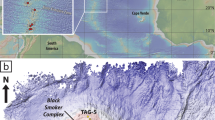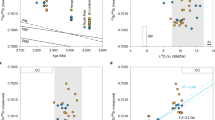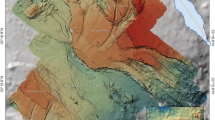Abstract
Hydrothermal circulation at oceanic spreading ridges causes sea water to penetrate to depths of 2 to 3 km in the oceanic crust where it is heated to ∼400 °C before venting at spectacular ‘black smokers’. These hydrothermal systems exert a strong influence on ocean chemistry1, yet their structure, longevity and magnitude remain largely unresolved2. The active Transatlantic Geotraverse (TAG) deposit, at 26° N on the Mid-Atlantic Ridge, is one of the largest, oldest and most intensively studied of the massive sulphide mounds that accumulate beneath black-smoker fields. Here we report ages of sulphides and anhydrites from the recently drilled3 TAG substrate structures — determined from 234U–230Th systematics analysed by thermal ionization mass spectrometry. The new precise ages combined with existing data4,5 show that the oldest material (11,000 to 37,000 years old) forms a layer across the centre of the deposit with younger material (2,300–7,800 years old) both above and below. This stratigraphy confirms that much of the sulphide and anhydrite are precipitated within the mound by mixing of entrained sea water with hydrothermal fluid6. The age distribution is consistent with episodic activity of the hydrothermal system recurring at intervals of up to 2,000 years.
This is a preview of subscription content, access via your institution
Access options
Subscribe to this journal
Receive 51 print issues and online access
$199.00 per year
only $3.90 per issue
Buy this article
- Purchase on Springer Link
- Instant access to full article PDF
Prices may be subject to local taxes which are calculated during checkout




Similar content being viewed by others
References
Edmond, J. M. et al. Ridge crest hydrothermal activity and the balances of the major and minor elements in the ocean: The Galapagos data. Earth Planet. Sci. Lett. 46, 1–18 (1979).
Elderfield, H. & Elderfield, H. & Schultz, A. Mid-ocean ridge hydrothermal fluxes and the chemical composition of the ocean. Annu. Rev. Earth Planet. Sci. 24, 191–224 (1996).
Humphris, S. E. et al. The internal structure of an active sea-floor massive sulphide deposit. Nature 377, 713–716 (1995).
Lalou, C. et al. New age data for Mid-Atlantic ridge hydrothermal sites: TAG and Snake Pit chronology revisited. J. Geophys. Res. 98, 9705–9713 (1993).
Lalou, C., Reyss, J. L. & Brichet, E. Age of sub-bottom sulphide samples at the TAG active mound. Proc. ODP Sci. Res. 158, 111–118 (1998).
James, R. H. & Elderfield, H. Chemistry of ore-forming fluids and mineral formation rates in an active hydrothermal sulfide deposit on the mid-Atlantic Ridge. Geology 24, 1147–1150 (1996).
Cann, J. R., Strens, M. R. & Rice, A. Asimple magma-driven thermal balance model for the formation of volcanogenic massive sulphides. Earth Planet. Sci. Lett. 76, 123–134 (1985).
Wilcock, S. D. & Delany, J. R. Mid-ocean ridge sulfide deposits: evidence for heat extraction from magma chambers or cracking fronts? Earth Planet. Sci. Lett. 145, 49–64 (1996).
Converse, D. R., Holland, H. D. & Edmond, J. M. Flow rates in the axial hot springs of the East Pacific Rise (21° N): implications for the heat budget and the formation of massive sulfide deposits. Earth Planet. Sci. Lett. 69, 159–175 (1984).
Schultz, A., Delany, J. R. & McDuff, R. E. On the partitioning of heat flux between diffuse and point souce venting. J. Geophys. Res. 97, 12299–12314 (1992).
Lister, C. R. B. Heat transfer between magmas and hydrothermal systems, or, six lemmas in search of a theorem. Geophys. J. Int. 120, 45–59 (1995).
Edwards, R. L., Chen, J. H. & Wasserburg, G. J. 238U–234U–230Th–232Th systematics and the precise measurement of time over the past 500,000 years. Earth Planet. Sci. Lett. 81, 175–192 (1986).
Mills, R., Thompson, J., Elderfield, H., Hinton, R. W. & Hyslop, E. Uranium enrichment in metalliferous sediments from the Mid-Atlantic Ridge. Earth Planet. Sci. Lett. 124, 35–47 (1994).
Henderson, G. M., Cohen, A. S. & O'Nions, R. K. 234U/238U ratios and 230Th ages for Hateruna Atoll corals: implications for coral diagenesis and seawater 234U/238U ratios. Earth Planet. Sci. Lett. 115, 65–73 (1993).
You, C.-F., Bickle, M. J., Mills, R., Nesbitt, R. & Butler, I. Age and uranium mobility in hydrothermal sulphides. Terra Nova(Abstr. Suppl. 9) 555 (1997).
Humphris, S. E. et al. Explanatory notes. Proc. ODP Init Rep. 158, 37–53 (1996).
Humphris, S. E. et al. Introduction and principal reuslts. Proc. ODP Init. Rep. 158, 5–14 (1996).
York, D. Least squares fitting of a straight line with correlated errors. Earth Planet. Sci. Lett. 5, 320–324 (1969).
Acknowledgements
We thank ODP and the staff at the Bremen core depository for collecting and curating samples; R. Mills, R. Nesbitt and I. Butler for discussions; and C. Lalou for making available a preprint of her work. This work was funded by NERC and the Newton Trust.
Author information
Authors and Affiliations
Corresponding author
Rights and permissions
About this article
Cite this article
You, CF., Bickle, M. Evolution of an active sea-floor massive sulphide deposit. Nature 394, 668–671 (1998). https://doi.org/10.1038/29279
Received:
Accepted:
Issue Date:
DOI: https://doi.org/10.1038/29279
This article is cited by
-
Record of hydrothermal activity in the Yuhuang hydrothermal field and its implications for the Southwest Indian Ridge: evidence from sulfide chronology
Acta Oceanologica Sinica (2023)
-
Geological context and vents morphology in the ultramafic-hosted Tianxiu field, Carlsberg Ridge
Acta Oceanologica Sinica (2023)
-
Mineral-scale variation in the trace metal and sulfur isotope composition of pyrite: implications for metal and sulfur sources in mafic VMS deposits
Mineralium Deposita (2022)
-
230Th/238U dating of hydrothermal sulfides from Duanqiao hydrothermal field, Southwest Indian Ridge
Marine Geophysical Research (2017)
Comments
By submitting a comment you agree to abide by our Terms and Community Guidelines. If you find something abusive or that does not comply with our terms or guidelines please flag it as inappropriate.



